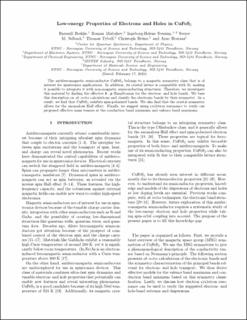| dc.contributor.author | Brekke, Bjørnulf | |
| dc.contributor.author | Malyshev, Roman | |
| dc.contributor.author | Svenum, Ingeborg-Helene | |
| dc.contributor.author | Selbach, Sverre Magnus | |
| dc.contributor.author | Tybell, Per Thomas Martin | |
| dc.contributor.author | Brüne, Christoph | |
| dc.contributor.author | Brataas, Arne | |
| dc.date.accessioned | 2023-03-07T09:10:14Z | |
| dc.date.available | 2023-03-07T09:10:14Z | |
| dc.date.created | 2023-01-13T09:33:10Z | |
| dc.date.issued | 2022 | |
| dc.identifier.citation | Physical review B (PRB). 2022, 106 (22), 1-12. | en_US |
| dc.identifier.issn | 2469-9950 | |
| dc.identifier.uri | https://hdl.handle.net/11250/3056289 | |
| dc.description.abstract | The antiferromagnetic semiconductor CuFeS2 belongs to a magnetic symmetry class that is of interest for spintronics applications. In addition, its crystal lattice is compatible with Si, making it possible to integrate it with nonmagnetic semiconducting structures. Therefore, we investigate this material by finding the effective k⋅p Hamiltonian for the electron and hole bands. We base this description on ab initio calculations and classify the electronic bands by their symmetry. As a result, we find that CuFeS2 exhibits spin-polarized bands. We also find that the crystal symmetry allows for the anomalous Hall effect. Finally, we suggest using cyclotron resonance to verify our proposed effective mass tensors at the conduction band minimum and valence band maximum. | en_US |
| dc.language.iso | eng | en_US |
| dc.publisher | American Physical Society | en_US |
| dc.subject | Spintronics | en_US |
| dc.subject | Spin-orbit coupling | en_US |
| dc.subject | Magnetism | en_US |
| dc.subject | Magnetic order | en_US |
| dc.subject | Hall effect | en_US |
| dc.subject | Electrical properties | en_US |
| dc.subject | Electrical conductivity | en_US |
| dc.subject | Density of states | en_US |
| dc.subject | Crystal phenomena | en_US |
| dc.title | Low-energy properties of electrons and holes in CuFeS2 | en_US |
| dc.title.alternative | Low-energy properties of electrons and holes in CuFeS2 | en_US |
| dc.type | Peer reviewed | en_US |
| dc.type | Journal article | en_US |
| dc.description.version | acceptedVersion | en_US |
| dc.source.pagenumber | 1-12 | en_US |
| dc.source.volume | 106 | en_US |
| dc.source.journal | Physical review B (PRB) | en_US |
| dc.source.issue | 22 | en_US |
| dc.identifier.doi | 10.1103/PhysRevB.106.224421 | |
| dc.identifier.cristin | 2106175 | |
| cristin.ispublished | true | |
| cristin.fulltext | original | |
| cristin.fulltext | postprint | |
| cristin.fulltext | postprint | |
| cristin.qualitycode | 2 | |
